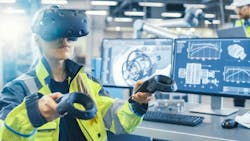LiDAR VR/AR Applications: Powering Virtual Reality
LiDAR VR/AR Applications
LiDAR VR/AR applications are taking augmented and virtual reality applications to the next level. Once far too expensive and bulky for consumer applications, today, a basic LiDAR system can be condensed to fit into a smartphone and cost less than a hundred dollars. Here, we’ll look at just how they work and what to expect from the combination of LiDAR and AR/VR.
What is LiDAR
Think of LiDAR as optical radar. An acronym for Light Detection and Ranging, it uses light waves from a laser to create a highly accurate, super-speedy 3D map of an object or area. The wavelength of the laser is typically 250 nm to 11μm, but it depends on the application requirements.
A quick working sensor makes time of flight (TOF) calculations determining just how long each laser pulse takes to reach the target and return and uses this raw data and point clouds to create a precise 3D map of terrain or objects and their placement in space. The intensity of the reflected light can provide extensive information, too, about the type of materials scanned and their density.
LiDAR scanners were originally developed for research purposes, especially meteorology applications. It was successfully used to map the surface of the moon back in 1971, but the technology behind it has improved dramatically and LiDAR today is cheaper, faster, and more powerful than ever before. This new affordability is part of the reason behind the explosion of LiDAR use across real-world industries today. We see it in self-driving cars, in speed enforcement, in stormwater management in agriculture, and in AR/VR.
LiDar and AR
Before the integration of LiDAR with augmented reality, AR was limited by clunky machine vision systems that struggled to provide precise real-time 3D mapping. Today, with precise spatial mapping at the speed of light, LiDAR gives AR and VR systems the potential to be faster, more accurate, and so more responsive.
When Apple integrated a miniature LiDAR system into the 2020 iPad Pro and iPhone Pro 12, the power of LiDAR became available to AR and VR app makers for the first time. Since then, they’ve been experimented with extensively. There’s more than one way that augmented reality (AR) and virtual reality systems can be improved by LiDAR integration. A few benefits of the integration include:
- Better Spatial Tracking
- Faster Placement of Virtual Objects
- Enhanced Realism
- Improved Depth Sensing
